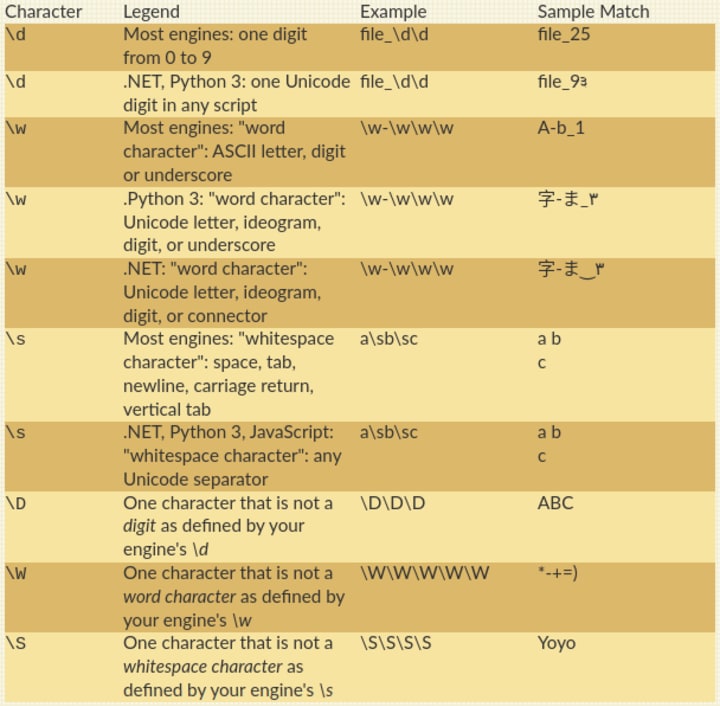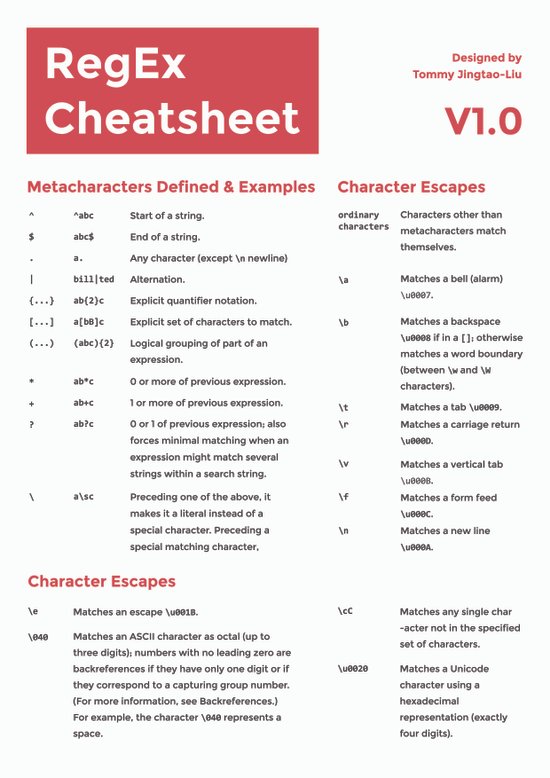Intro
The following characters are reserved: []().^$|?*+{}. You’ll need to escape these characters in your patterns to match them in your input strings.
There’s a static method of the regex class that can escape text for you.
Ref:
Logical grouping of part of an expression. 0 or more of previous expression. + 1 or more of previous expression.? 0 or 1 of previous expression; also forces minimal matching when an expression might match several strings within a search string. Preceding one of the above, it makes it a literal instead of a special character. Regular expressions can be made case insensitive using (?i). In backreferences, the strings can be converted to lower or upper case using L or U (e.g. This requires PERL = TRUE. CC BY Ian Kopacka. ian.kopacka@ages.at Regular expressions can conveniently be created using rex::rex. Regex cheat sheet of all shortcuts and commands. Match a single white space character (space, tab, form feed, or line feed). R (?=e) d — match 'r' (IF FOLLOWED BY 'e') then see if 'd' comes after 'r' The lookahead seeks 'e' only for the sake of matching 'r'. Because the lookahead condition is ZERO-width, the expression is logically impossible. It requires the 2nd character to be both 'e' and 'd'. Regex Cheat Sheet (Regular Expressions) Last Updated on September 14, 2020 by RapidAPI Staff Leave a Comment Regular Expression or regex is a text string that permits developers to build a pattern that can help them match, manage, and locate text.
Named Capture Groups

Because $Matches is of type [Hashtable] we can convert it directly to a [PSCustomObject]:
If you need the properties to be in a specific order this won’t work. But you can use a class for that instead:
Substitutions
The substitution is done by using the $ character before the group identifier.
Two ways to reference capturing groups are by Number and by Name.
R Regular Expression Cheat Sheet Excel
By Number - Capturing Groups are numbered from left to right.
By Name - Capturing Groups can also be referenced by name.
The $& expression represents all the text matched.
WARNING
Since the $ character is used in string expansion, you’ll need to use literal strings with substitution, or escape the $ character when using double quotes.
Additionally, if you want to have the $ as a literal character, use $$ instead of the normal escape characters. When using double quotes, still escape all instances of $ to avoid incorrect substitution.
Unicode Code Point ranges
Explanation:
The ranges of Unicode characters which are routinely used for Chinese and Japanese text are:
- U+3040 - U+30FF: hiragana and katakana (Japanese only)
- U+3400 - U+4DBF: CJK unified ideographs extension A (Chinese, Japanese, and Korean)
- U+4E00 - U+9FFF: CJK unified ideographs (Chinese, Japanese, and Korean)
- U+F900 - U+FAFF: CJK compatibility ideographs (Chinese, Japanese, and Korean)
- U+FF66 - U+FF9F: half-width katakana (Japanese only)
As a regular expression, this would be expressed as:
This does not include every character which will appear in Chinese and Japanese text, but any significant piece of typical Chinese or Japanese text will be mostly made up of characters from these ranges.
Note that this regular expression will also match on Korean text that contains hanja. This is an unavoidable result of Han unification.
Unicode regex’s let you use code-point ranges or: 1 scripts, [2] blocks, or [3] categories
Blocks are sequential:
U+3400 - U+4DBF is p{InCJK_Unified_Ideographs_Extension_A}U+4E00 - U+9FFF is p{InCJK_Unified_Ideographs}
R Regular Expression Cheat Sheet Answers
quote (from below) Some languages are composed of multiple scripts. There is no Japanese Unicode script. Instead, Unicode offers the Hiragana, Katakana, Han, and Latin scripts that Japanese documents are usually composed of.
Here are some refs:
Regex Options

There are overloads of the static [Regex]::Match() method that allow to provide the desired [RegexOptions] programmatically:

Options are ([System.Text.RegularExpressions.RegexOptions] | Get-Member -Static -MemberType Property):
Regex Guide

- Compiled
- CultureInvariant
- ECMAScript
- ExplicitCapture
- IgnoreCase
- IgnorePatternWhitespace
- Multiline
- None
- RightToLeft
- Singleline

R Regular Expression Cheat Sheet Worksheet
Ref:
